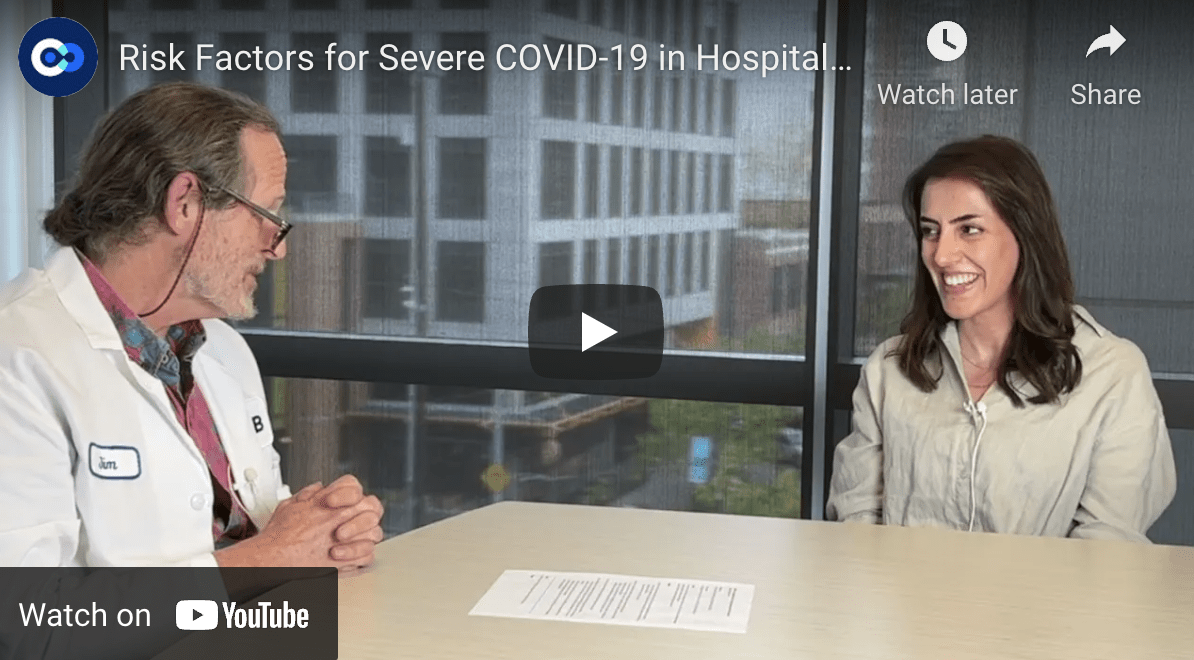Risk Factors for Severe COVID-19 in Hospitalized Adults Differ by Age
 hadlock.isbscience.org/news/2022/04/28/risk-factors-for-severe-covid-19-in-hospitalized-adults-differ-by-age/
hadlock.isbscience.org/news/2022/04/28/risk-factors-for-severe-covid-19-in-hospitalized-adults-differ-by-age/In the video above, Dr. Sevda Molani, lead author of a paper published in the journal Scientific Reports, discusses her work with ISB President Dr. Jim Heath. An ISB-led study has shed light on which hospitalized COVID-19 patients are most likely to need mechanical ventilation or to die.
A just-published study provides previously unknown answers about which hospitalized COVID-19 patients are most likely to need mechanical ventilation or to die.
Researchers showed that vital signs and lab results at the time of hospital admission are the most accurate predictors of severe COVID-19.
“Our models show that chronic conditions, comorbidities, sex, race and ethnicity are much less important in the hospital setting for early prediction of critical illness,” said Dr. Sevda Molani, lead author of a paper published in the journal Scientific Reports.
Molani and team looked at risk factors based on two age groups of hospitalized patients, one being between 18 and 50 years old and the other being 50 or older, and found that risk factors that lead to severe cases and/or death differ with younger vs. older patients.
For example:
- Body mass index is a more important predictor of COVID-19 severity for younger patients than for older patients.
- Many comorbidities such as malignancy, cardiomyopathy and COPD have higher odds ratios for severe outcomes in younger patients than in older patients.
- For both older and younger patients, vital signs, early hospital laboratory tests and the need for supplemental oxygen are more useful for predicting severe outcomes than comorbidities and demographics.
The findings are meaningful in the clinical setting.
“Risk prediction in COVID-19 is complex as the disease course is highly variable between persons, ranging from completely asymptomatic in some people to critical illness or death in others. While age is known to be highly predictive of death, other risk factors within age strata are incompletely explored,” said Dr. Jason Goldman, an infectious disease specialist at Swedish Providence and a member of the study team.
“This study challenges our dogma that comorbidities are the major drivers of severe outcomes like mechanical ventilation or death in hospitalized patients with COVID-19. Instead, we find that other physiological features that can be measured within one hour of hospitalization more strongly predict who will go on to severe outcomes. “These findings remind the treating clinician to incorporate physiological parameters into risk stratification, and subsequently into decisions on treatment allocations,” Goldman said.
The retrospective study examined the electronic health records of more than 6,900 patients between June 31 and November 15 of 2021. The vast majority of patients hospitalized with COVID-19 – 92 percent of the younger patients and 75 percent of the older patients – had not received COVID-19 vaccination.
Existing risk models for hospitalized patients were developed early on in the pandemic. This research addresses the need for updated models that reflect current standard of care for COVID-19, where fewer uncommon labs are used, and more therapeutic treatment options are available. Future investigations will benefit from finer granularity of subdivisions by age, BMI, and more detailed variables on conditions and drugs that affect individual immune response.
“Chronic medical conditions are still important risk factors for severe COVID-19. However, when a patient has just been admitted to the hospital, their current status can be more helpful in predicting what level of care they are likely to need,” said ISB Assistant Professor Dr. Jennifer Hadlock, corresponding author of the study. “As the standards of care for COVID-19 evolve, our risk models need to evolve with them.”
The collaborative study was conducted by researchers at ISB, Swedish Providence, Onegevity and Mayo Clinic Jacksonville.





